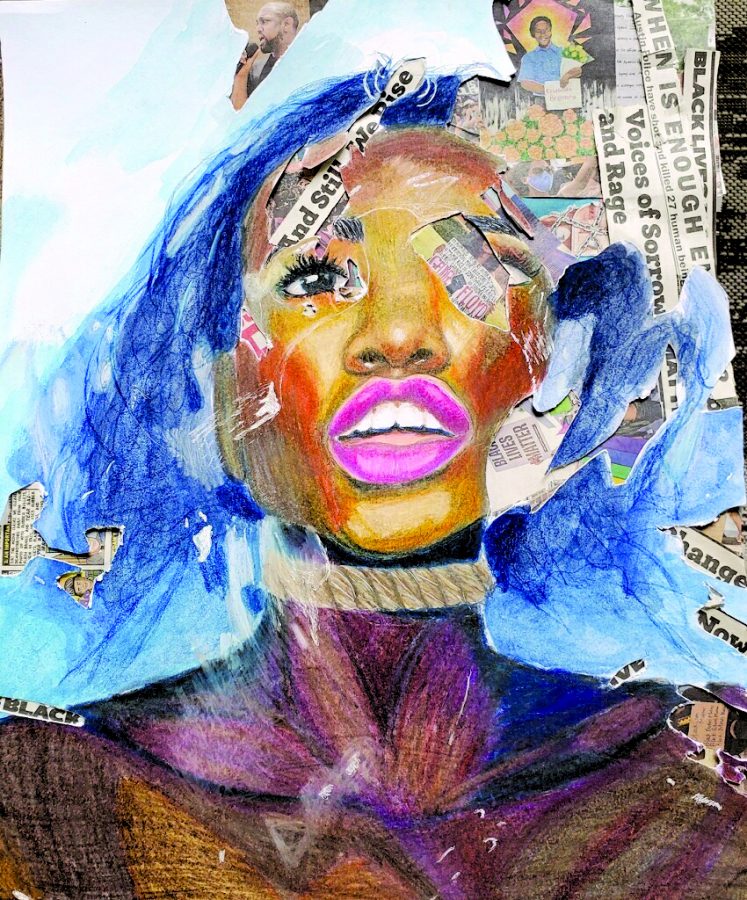Student brings attention to BLM through her artwork
The portrait captures a girl staring into the sky, surrounded by calls for justice and change. As part of a portfolio themed on social justice, senior Kaylin York desired for her AP Studio Art piece to express the essence of the Black Lives Matter movement and the need for immediate action.
November 11, 2020
In the Black girl’s eye, a “Justice for George Floyd” poster calls for change. Her other eye is looking to the sky, suspended between an outcry to the universe. Rising above it all are three words: BLACK LIVES MATTER.
The Black Lives Matter movement was the topic that senior Kaylin York chose for her artwork when she was assigned a political activist piece for AP Studio Art, she knew her goal was to spread awareness about the movement, reactivated by George Floyd’s murder.
York’s experiences as a Black person prompted her passion for the Black Lives Matter Movement.
“I was told from a young age that I, my brother, or anyone on my dad’s side of the family could be killed because of the color of our skin,” York said. “I wanted to express the pain that my family and our ancestors have faced, and still face, to call out the injustice and racism in this country.”
She wants future generations to not be subjected to senseless violence based on their race.
“[BLM] means getting to see the nightmares my ancestors faced finally being put to rest,” York said. “Getting justice for those who have been failed by humanity because they were living in America while Black.”
She hopes that other students will see the greater context of Black inequality.
“Every day, another Black mother [has] to hear her son won’t make it home for dinner, [that] her brother won’t make it to her game,” York said. “A child learning daddy will never tuck her in before bed again.”
York uses optimism in her piece to signify that America is finally acknowledging the pain and suffering of African Americans through the lens of the BLM movement.
“The slaughter of Black Americans has become normal, and that needs to end here. With our generation,” York said. “So that the Black community won’t have to fear walking home in the dark one minute and being shot the next.”
AP Art teacher Laura Dubois, believes York’s use of mixed mediums strengthened the political statement of her piece.
“I found [Kaylin’s] work to be both impressive and emotional,” Dubois said. “Kaylin puts her viewer in the ‘shoes’ of a Black person. That’s important and something you can’t teach.”
Dubois wanted to challenge her students to create an impactful piece while also providing a platform for the next generation of artists.
“It provides the viewer with an opportunity to put themselves in ‘someone else’s shoes’ and could possibly change ones’ outlook,” Dubois said. “We all have different opinions and ideas, but it’s important we learn from each other and educate ourselves.”
Using art to explore political statements allows her, as well as other students, to convey complex issues in easily digestible formats.
“The use of visual symbolism can help people sympathize more with the victims of these issues more than words sometimes can,” senior Savannah Nuhn said. “Visual art has a rather universal language that most people can understand.”
Nuhn, a BLM ally, created a minimalist piece in hopes of evoking striking simplicity.
“I [went for] a sort of symbolic approach, having birds represent the USA and the Black community, seeing as flight is used as a symbol of freedom,” Nuhn said. “In my piece, I wanted to convey that while the modern African American community may have wings, they are often damaged and tied down by fellow Americans, and their calls for help are more often than not ignored by the higher authorities of the USA.”
Nuhn’s position as a supporter and ally differentiates her message from York’s.
“African Americans are people too and should be respected as such by each and every member of society,” Nuhn said. “To me, being an ally means supporting those around you who are affected and using what privilege you have to send a message.”
York has been honing her skills since she was nine years old and wants to pursue a career in portrait-illustrations.
“Being someone who switched schools many times, art helped me express who I was and make [new] friends,” York said. “I like to make art because it brings me joy, but I can [also] tell a story with it.”
Both York and Nuhn find AP Studio Art to be a great resource for building their portfolios and enhancing their unique approach to art.
“I can learn from my peers through critique and seeing how their processes differ from mine. We have a lot of freedom to create what we want,” Nuhn said. “I see it as a time to do what I enjoy while chatting with like-minded people who also understand the process of creating this art.”
The project for the class acts as a focal point in their first-semester college portfolios. These portfolios will continue to grow throughout the year, showcasing many different art pieces of their topic.
“Students chose to develop a [social issue] piece on something that personally impacted them,” Dubois said. “AP Studio Art is a mature class and art isn’t always just about ‘a pretty picture’. I want to challenge my students with their critical thinking skills, and reflect on current events and creativity.”










